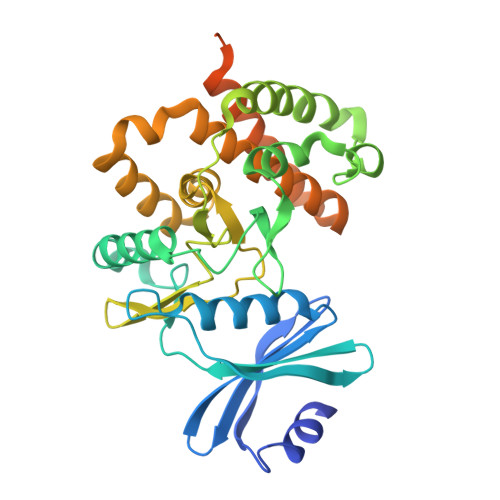Crystal structures of the ternary complex of APH(4)-Ia/Hph with hygromycin B and an ATP analog using a thermostable mutant.
Iino, D., Takakura, Y., Fukano, K., Sasaki, Y., Hoshino, T., Ohsawa, K., Nakamura, A., Yajima, S.(2013) J Struct Biol 183: 76-85
- PubMed: 23747390
- DOI: https://doi.org/10.1016/j.jsb.2013.05.023
- Primary Citation of Related Structures:
3W0M, 3W0N, 3W0O, 3W0P, 3W0Q, 3W0R, 3W0S - PubMed Abstract:
Aminoglycoside 4-phosphotransferase-Ia (APH(4)-Ia)/Hygromycin B phosphotransferase (Hph) inactivates the aminoglycoside antibiotic hygromycin B (hygB) via phosphorylation. The crystal structure of the binary complex of APH(4)-Ia with hygB was recently reported. To characterize substrate recognition by the enzyme, we determined the crystal structure of the ternary complex of non-hydrolyzable ATP analog AMP-PNP and hygB with wild-type, thermostable Hph mutant Hph5, and apo-mutant enzyme forms. The comparison between the ternary complex and apo structures revealed that Hph undergoes domain movement upon binding of AMP-PNP and hygB. This was about half amount of the case of APH(9)-Ia. We also determined the crystal structures of mutants in which the conserved, catalytically important residues Asp198 and Asn203, and the non-conserved Asn202, were converted to Ala, revealing the importance of Asn202 for catalysis. Hph5 contains five amino acid substitutions that alter its thermostability by 16°C; its structure revealed that 4/5 mutations in Hph5 are located in the hydrophobic core and appear to increase thermostability by strengthening hydrophobic interactions.
Organizational Affiliation:
Department of Bioscience, Tokyo University of Agriculture, 1-1-1 Sakuragaoka, Setagaya-ku, Tokyo 156-8502, Japan.




















